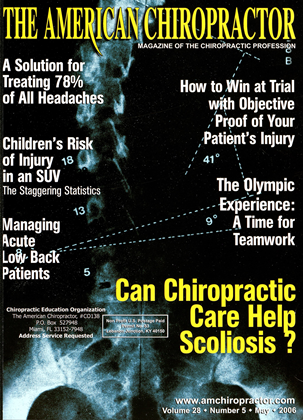Statistically, 78% of all headaches can be related to biomechanical problems in the upper cervical spine and can be effectively treated by a chiropractor. H EADACHE DISORDERS ACCOUNT FOR ABOUT 120 million lost workdays per year in the United States, alone. Controversy exists to explain the "mechanism" of all types of headaches, particularly cervicogenic headaches. Tension-type headaches account for 78% of all headaches and, statistically, this includes the so-called "cervicogenic headache." Because of the results we see in our offices treating headache, it seems almost all headaches can be related to biomechanical problems in the upper cervical spine, thus cervicogenic in origin. Past research and opinion has not agreed. However, recent research publications and conference presentations are starting to explain how our headache patients benefit from chiropractic treatment. The International Headache Society (1HS) recently published its second edition of headache classifications. Headaches are divided into Primary and Secondary. Primary headaches account for 94% of all headaches and are made up of Tension/Stress (78%) followed by Migraines (16%). The "Secondary" category of headaches only accounts for 6% of the total, which are related to an underlying pathology as in the case of the patient's having a tumor. Dr. Nikolai Bogduk, in The Anatomical Basis of Cen'icogenic Headache, explains: "By definition, cervicogenic headache is a pain in the head whose source lies somewhere in the cervical spine." Technically, a cervicogenic headache constitutes a particular form of referred pain from the cervical spine. As illustrated, the convergence of affcrents from the trigcminal nucleus, pons and the upper three or four cervical spinal nerves provides for various patterns of referred pain. (See Fig A) The definition implies an anatomical and physiological connection between the nerves of the cervical spine and the mechanisms of headache. Research now shows that the following structures represent the possible sources of headache pain referred from the cervical spine: Medial Atlanto-Axial Joint, Atlanto-Occipital Joint, Lateral Atlanto-Axial Joint, C2-3 Zygapophyseal Joint, Suboccipilal and Upper Posterior Neck Muscles, Upper Prcvertebral Muscles, Spinal and Posterior Cranial Fossa Dura Matter, C2-3 Intervertebral disc, Trapezius, Sternocleidomastoid. Dr. Shaun Watson, PhD, FRACP, lists the following clinical characteristics of cervicogenic headaches: Cervicogenic headache is unilateral and does not change sides (however, minor contralateral pain is accepted). The headache commences in the neck and spreads forward. Posture or movement often triggers headache. May be associated with shoulder/arm pain. Mild to moderate in intensity, and rarely excruciat ing. May be antecedent to trauma. There is ipsilateral upper cervical hypomobility. Presence of focal tenderness and triggering of pain. Support for the use of chiropractic care in treating headaches can be found in A Systematic Review of Spinal Manipulative Therapy (SMT) for Migraine and Migraine-Like Headache, by Tuchin, Bonello, and Pollard. Their research included 14 studies, with a total of 1848 patients, ranging in ages from 12-78 years. Accepted were three (3) randomized controlled trials and three (3) clinical trials for migraines. A total of five (5) studies were for migraine-like headaches. The conclusion was, "There is moderate evidence of support that SMT gives significant improvement in migraines and migraine-like headaches." Further, in research of randomized controlled trials. Dr. Shaun Watson found that there was a greater than 50% reduction in headache, both acutely and at 12 months, with spinal manipulation and/or an exercise program. And Dr. Grunnet-Nilsson, DC, MD, PhD, found research supporting that "a 6-8 week course of spinal manipulation will significantly improve headache frequency, intensity, medication use, etc., positively affecting almost all headache outcome variables." In summary, there is strong evidence emerging with regard to the anatomical connection between the brain, and upper cervical spine, the occiput through C3, even into C5, trapezius and stemocleido-mastoid, and the role these play in all types of headaches. With any type of "headache," special attention in evaluating all of these structures for biomechanical dysfunction needs to be performed. Activator Methods Technique incorporates Isolation Tests, Stress Tests, and Leg Length Analysis to determine specific contact points and Lines of Drive in the corrections of biomechanical dysfiinctions with the Activator Instrument. Currently the Activator Methods Technique has over 100 tests a doctor could choose from for the analysis of headache-related structures alone. The 2006-2007 Activator Methods Seminar season will include advanced, concentrated studies on the subject of headaches. „ .. ., See references on pg. 63 Dr. Rebecca S. Fischer has been practicing for over 24 rears. She has been Advanced Proficiency Rated with Activator Methods for 19 years, and instructing for 15 years. She is currently a Senior Clinical Instructor, Curriculum Coordinator, and Secretaiy of the Clinical Advisory Board for Activator Methods International. I Web Site Resources The entire 150 pages of Cephalgia, The International Classifications of Headache Disorders, 2nd ed.. Vol. 24. Supplement 1, 2004, can be accessed and downloaded at http://216.25.100.131/ihscommon/ guidelines/guide, htm. The World Federation Headache website has a downloadable abstract of the IHS Guides at www. headaches.org. Abstracts from the June 2005 World Federation of Chiropractic, 8th Biennial Congress can be accessed at www.wfc.org. A disc with all of the proceedings can be purchased. wvvw.activator.com contains information such as published research, upcoming seminars, products, and listings of Activator Methods Technique, Proliciency and Advanced Proficiency Rated Doctors worldwide. STRONG EVIDENCE makes an anatomical connection between the brain and upper cervicals, and the role these play in all types of headaches, which can be effectively treated by a chiropractor. The Activator Method is uniquely suited for upper cervical work and has over 100 tests doctors can use for the effective analysis and treatment of headache pain.
 View Full Issue
View Full Issue






